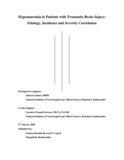Please use this identifier to cite or link to this item:
https://hdl.handle.net/20.500.14356/493| Title: | Hyponatremia in Patients with Traumatic Brain Injury: Etiology, Incidence and Severity Correlation |
| Authors: | Nepal Health Research Council (NHRC), Ramshah Path, Kathmandu, Nepal |
| Issue Date: | 2009 |
| Publisher: | Nepal Health Research Council |
| Abstract: | Hyponatremia is common in neurosurgical population, prominently in patients with Sub-Arachnoid Hemorrhage (SAH) and TraumaticBrain Injury (TBI). Two common etiologies, namely the Syndrome of Inappropriate Anti-Diuretic Hormone (SIADH) and Cerebral Salt Wasting Syndrome (CSWS), are primarily responsible. Differentiation among two conditions is based on volume status of patient. Given a typical case scenario, distinction might not appear difficult. Yet, exceeding number of cases have a borderline picture with diagnostic confusion and impediment in therapeutic intervention. Researchers are thus making an attempt of differentiation based on biochemical alterations. This is a prospectively designed study on hyponatremia in patients with TBI. All patients above 16 years with moderate to severe head injury and mild ones withintracranial lesion on CT scan were enrolled in the study. Overa period of 6 months, 40 patients fulfilled the criteria. Serum sodium level was monitored daily till 14thday. Central Venous Pressure (CVP) measurement was done for the assessment of volume status. All patients with moderate or severe head injury and those who underwent surgical evacuation of lesion had routine CVP catheter insertion. In the remaining, CVP was inserted after detection of hyponatremia. Correct position of CVP catheter was confirmed in all the cases with post-procedure check x-ray; with contrast injection if necessary. Measurement of Fractional Excretion of Uric Acid (FEUA) was done inall cases at the detection of hyponatremia and after its correction. Since volume depletion is hazardous in TBI patients, fluid restriction was not done even with a diagnosis that was consistent with SIADH. Oral salt supplementation and intravenous normal saline was the first line management in all hyponatremic patients. If patients did not respond to this, then moderate fluid restriction (1500 ml/day) was done for SIADH and oral fludrocortisone was used for CSWS. Out of 40 consecutive patientsenrolled in the study, seven were excluded from the analysis for several reasons; early mortality, transfer to other centres or medical co-morbidities likely to produce hyponatremia. Of33 patients that remained for analysis, nine (27.27%) developed hyponatremia. Mean age of hyponatremic patients was 38.44 years with 55.6% patients of 17-30 age group, and male to female ratio of 3.5:1. Mild, moderate and severe head injury formed 36.36, 27.27 and 36.36% respectively. Hyponatremia occurred at the same incidence of 33.33% in both mild and moderate injuries, while in severe cases, the incidence was only 16.66%. Hyponatremia was seen in Rotterdam CTscore two, three and four in increasing incidence of 22.2, 33.3 and 44.4% respectively (r 0.983, p value 0.017), while there was no significant correlation withinitial GCS (p value 0.15). All patients had some form of abnormality in CT scan. Frontal location was the most common site, both among total patients and hyponatremic patients, 63.6 and 66.7% respectively. Intraparenchymal lesion was the most common CT abnormality overall as well as inhyponatremic patients, 66.7 and 88.9% respectively. None of them had an intraventricular extension. There were eight (88.9%), three, two and one patients respectively with intraparenchymal lesion, epidural hematoma, pneumocephalus and traumatic SAH who developed hyponatremia; three had more than one type of lesion. All varieties of the lesions were associated with hyponatremia, but none of the four patients with subdural lesions showed hyponatremia. Right and left unilateral, and bilateral lesions were all associated with equal incidence of hyponatremia of 33.33%. Based on volume status, among nine hyponatremic patients, five (55.5%) had SIADH, three (33.3%) had CSWS and remaining one had inconclusive picture. All patients, but one, responded well to above mentioned first line treatment strategy. One patient required fludrocortisone in addition. Six patients (66.6%) developed hyponatremia within first weekof injury. Mean duration of hyponatremia was 1.78 days. Inthree patients it lasted for two days, while in two other, it lasted for three days. One patient had hyponatremia 113 mEq/L and the other down to 120 mEq/L. Rest of the patients had sodium levels above 125 mEq/L. Two patients had recurrence of hyponatremia, at 11th and 12th day, both of which were corrected within a day with first line treatment. Measurement of FEUA prior to and after correction of hyponatremia did not reveal consistent measurements as suggested in the literature. Mean hospital stay was 26.73, 27.5 and 24.67 days among total, non-hyponatremic and hyponatremic patients. Similarly, mean Glasgow Outcome at discharge was 3, 2.92 and 3.22. There was no significant difference of means in duration of hospital stay or GOS at discharge. Regarding the type, site and side of the lesion, Glasgow Coma Scale at the time of presentation, surgical intervention, individual CT characteristics, Rotterdam CT score, mean hospital stay and GOS at discharge, none of the variables were found to have significant association with the occurrence of hyponatremia. |
| URI: | http://103.69.126.140:8080/handle/20.500.14356/493 |
| Appears in Collections: | NHRC Research Report |
Items in DSpace are protected by copyright, with all rights reserved, unless otherwise indicated.

